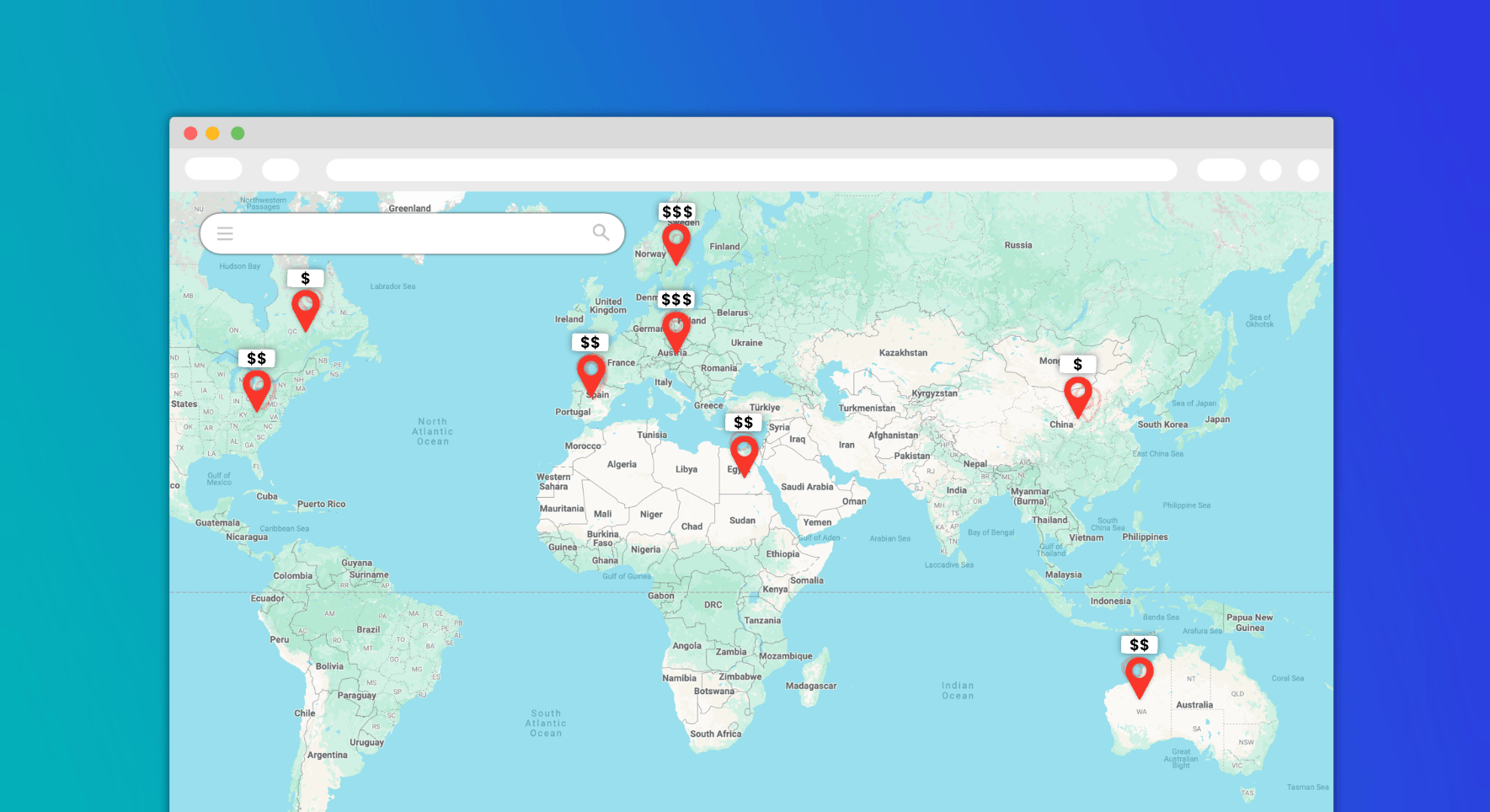Between 2022 and 2023, the global e-commerce market grew from $5.7 trillion to around $8.1 trillion. Big number, right? You could almost buy a 1-bed apartment with that kind of money in today’s economy.
Yet data shows that the staggering growth of e-commerce does not equal the demise of in-store shopping. According to a 2021 study published by Frontiers in Psychology, a staggering 84% of global sales still occur in physical stores – and 46% of consumers prefer it that way.
Brick-and-mortar stores aren’t going anywhere – and Google, in their infinite wisdom, is aware of this. That’s why they introduced Google Ads store visits and store visit conversions – giving businesses the ability to understand exactly how much in-store foot traffic their ad campaigns were driving.
Here, we’ll take a deep dive into Google Ads store visits, and equip you with the knowledge to leverage this feature and maximize your in-store conversion rates. We’ll explore:
- What Google Ads store visits are
- The benefits of using them
- How Google tracks and measures in-store visits and conversions
- Eligibility requirements and getting started
- Optimizing campaigns for in-store visits
- Advanced campaign strategies to further increase foot traffic
- Using in-store metrics to drive conversions
What Are Google Ads Store Visits?
In the past, tracking in-store visits from online ads was a real Homo neanderthalensis in the world of advertising, and a completely dark area for marketers looking to prove in-store ROI from online ad campaigns.
Fortunately, Google Ads introduced store visits in late 2014, and they’ve been busy improving and optimizing them ever since.
Using Google’s sophisticated web of user analytics and location data, Google Ads store visits estimate the number of people who clicked on your ad and subsequently visited your physical store within a designated period (typically 30 days).
This provides a crucial missing piece in the marketing puzzle, allowing businesses to see beyond online conversions and gather a much clearer picture of the real-world impact of their ad campaigns.
How Does Google Track Store Visit Conversions?
In order to fully understand and optimize your store visit conversions, it’s important to know how they’re tracked.
In order to make store conversions “99 percent accurate” (according to Google), Google Ads works synergistically with Google Maps.
Google Maps knows the exact location for over 2 million businesses across the globe. Google Ads can then combine and compare this information with its user tracking data, ultimately providing us with in-store conversion tracking.
Of course, the reality is slightly more complicated than that. Google employs a hybrid approach with a wide range of signals in order to measure visits accurately. These include:
- User location history
- GPS location signals
- In-store Wi-Fi connections and signal strength
- Bluetooth beacons
- Google Maps and Google Earth street view data
- The exact coordinates of millions of physical stores worldwide
- Machine learning and modeling
- Google opinion rewards surveys (real users getting paid to verify and calibrate location data)
Advertise to Humans, Not Bots
Get a demo and save up to 20% of your advertising budget by automatically eliminating fake ad clicks across all paid channels.
The Benefits of Using Google Ads Store Visits
Now you know the how, let’s look at the why.
By making Google Ads store visits an integral part of your marketing strategy, you will:
- Measure the true customer journey – Store visit metrics let you paint a holistic picture of your customer journey, allowing you to understand how your online efforts translate into real-world customer behavior. This gives you valuable insights into the effectiveness of your overall marketing efforts and lets you pin-point weaknesses in your user journeys and marketing funnels.
- Boost overall ROI – Identify which campaigns, devices, ad formats, and keywords drive the most in-store conversions with store visit metrics. You can use this data to optimize your ad spend for maximum impact and conversions, ensuring you’re spending your budget on the strategies generating the most revenue for your business.
- Support smart bidding strategies – By factoring in store visit data, Google’s smart bidding strategies can prioritize campaigns and adjust bids in real time to attract the customers most likely to visit your store. This can significantly boost ROI for certain campaign types, and is one of the most effective strategies for increasing in-store footfall.
- Gain a competitive edge – By understanding the offline impact of your online advertising efforts, you’ll immediately gain a significant advantage over your competitors who solely rely on online conversion metrics. By gathering both online and offline metrics, you can refine your strategy and gain a stronger foothold in your industry.
Understanding offline conversions is crucial for successful advertising. By tracking offline conversions, you gain deeper insights and optimize your campaigns effectively for improved business outcomes.
Getting Started with Google Ads Store Visit Conversions
Before you start leveraging the power of Google Ads store visits, you’ll need to meet a few key eligibility requirements:
Eligibility Requirements
- Industry – A tad obvious perhaps, but your business category will need to be eligible for store visit conversions. In other words, you’ll need to operate in an industry where businesses typically have a physical store presence.
- Location – Your business location(s) need to be fully verified on Google My Business. GMB lets you choose your exact store locations and ensures a seamless integration with Google Maps.
- Google Account – Once you’ve verified your business location on GMB, you’ll need to link your Google Ads account to your Google My Business profile. This facilitates the connection between online ads and physical stores.
And just like that, you’re now ready to measure and optimize your online ad campaigns for in-store visits and conversions.
Optimizing Campaigns for Google Ads Store Visits
Now you’re eligible to measure store visit conversions, let’s talk about some practical strategies you can use to optimize ad campaigns for in-store performance:
- Location targeting – Target your ads to users near your physical stores to get more people through the doors and significantly increase awareness for nearby users. To do this, go into your Google Ads account and define specific high-value geographic targeting areas around your store. Google Ads will then serve your ads to the users based in those locations who are most likely to visit.
- Location assets – Google Ads has a feature called ‘location assets’ – use this to showcase your store address, phone number, or other information within your ad itself. This is a great way to provide users with all the information they need to visit your store. It also prevents potential customers from having to manually search for your store address or contact information after viewing your ad.
- Call extensions – By including call extensions within your ads, you’re directly opening a line of communication between you and potential customers. Allow them to directly contact your store for directions, product availability or information, and other enquiries. This can be a powerful tool for gaining customers and driving immediate store visits.
- Mobile optimization – Even the most dedicated internet users tend not to use their laptop (or drag their desktop PC around with them) when they’re on-the-go. Your local store ads should reflect this by being optimized towards mobile devices and mobile search. Responsive design and ultra-clear CTAs are vital for driving store visits on mobile.
- In-store promotional offers – Tempt your customers by highlighting exclusive in-store deals or promotions within your ads. The right promotion will be a key driver for immediate in-store visits, so take the time to perform thorough customer research and offer them an irresistible deal.
- Optimized landing pages – Unless you run a local escape room, your customers won’t appreciate an Indiana Jones-style treasure hunt in order to locate your store. Seamlessly convert ad clicks into store visits by providing clear directions to your store location, include map integration, and highlight your store address and contact information on your landing pages.
Advanced Strategies to Increase Foot Traffic
Already optimized your campaigns? Looking for some more advanced strategies to unlock even greater performance from Google Ads store visits? Then let’s get into the technical stuff.
These strategies may require a greater deal of coordination and communication between online and offline segments of your business – but can pay dividends with a coherent user experience that drives in-store traffic.
- Customer match audiences – Customer match audience targeting allows you to reach existing site visitors or customers who have interacted with your brand online. Re-engage high-value users with targeted ad campaigns specifically designed to drive in-store visits by leveraging Google’s customer match audience targeting.
- Omnichannel marketing integration – By integrating your Google Ads store visit strategy with your broader omnichannel marketing, you can create a cohesive end-to-end customer journey that ultimately leads to physical store visits. Use social media campaigns, email marketing, and in-store signage to reinforce online messaging and create a straightforward user journey that remains consistent at every touchpoint.
- Highlight in-store services – By showcasing unique in-store services or experiences online, you’re immediately differentiating yourself from online-only competitors. Think personalized demonstrations, consultations, or in-store events. By highlighting unique in-store offerings, you can drive users to your physical stores.
Using In-Store Metrics to Drive Conversions
Like most marketing efforts, simply implementing these strategies isn’t the ‘final step’ towards greater in-store traffic.
Monitoring the progress and effectiveness of your ad campaigns, then making tweaks and changes based on the data you’re getting, is crucial for campaigns that continue to tempt new and existing customers into your stores.
Let’s look at the key methods of measuring success and leveraging the insights you get from in-store metrics:
Track key metrics
Let’s go obvious early. In order to get more people through your doors, it’s vital to monitor all your KPIs closely. This doesn’t mean taking a glance at your number of store visits every now and then – it means taking a deep-dive into all your in-store metrics to see exactly how online activity correlates with offline conversions.
Key KPIs for in-store visits include:
- Number of store visits
- Cost-per-store visit
- Average value of each store visit
- Return on ad spend (ROAS)
Consider the cost associated with each store visit to understand the overall effectiveness and profitability of your campaigns.
Embrace attribution modeling
Use attribution modeling within Google Ads to understand the multi-touch attribution of store visits.
You can use attribution modeling to determine the touchpoints in your marketing funnel that play the biggest role in generating in-store conversions.
This is why it’s important to understand the synergy between both marketing channels, and know exactly how they influence the customer journey. This lets you optimize your budget allocation, ensuring you invest in the channels that have the greatest impact on driving in-store traffic through Google Ads.
A/B Testing
Similar to e-commerce campaigns, you’ll want to compare and contrast every campaign element you can in order to identify the most effective elements that drive users through your doors.
Here’s a handy A/B testing checklist you can use for store visit conversion campaigns:
- Visuals
- Headlines
- Ad copy
- CTAs
- Landing page designs
- Promotional offers
- Targeting strategies
Final Thoughts
By implementing the strategies mentioned above, and by closely measuring their effectiveness, you can gain a deeper understanding of your entire customer journey, optimize your ads for in-store conversions, and ultimately get far more use out of your shop doors.
By taking an approach that bridges the gap between online and offline experiences, you’re well on your way towards optimizing the whole buying process for your customers – making it easy for them to transact with your business.
However, no matter how well-optimized your ad campaigns are for driving in-store conversions, you’re still going to fall prey to fake clicks and other sources of invalid traffic. In fact, our Wasted Ad Spend Report showed that 1 in 12 clicks are fake.
Makes you wonder – what’s the point in optimizing your ad campaigns to meet your goals, if such a large percentage of clicks and views aren’t going to lead anywhere?
Fortunately, invalid traffic protection is the not-so-secret weapon being used by well over 60,000 brands to protect their ad spend and gain far greater control and visibility over who (or what) is clicking on your campaigns.
Get a free, no obligation traffic audit with Lunio to discover exactly how much invalid traffic is costing you.
Advertise to Humans, Not Bots
Save up to 20% of your advertising budget by automatically eliminating fake ad clicks across all paid channels.






